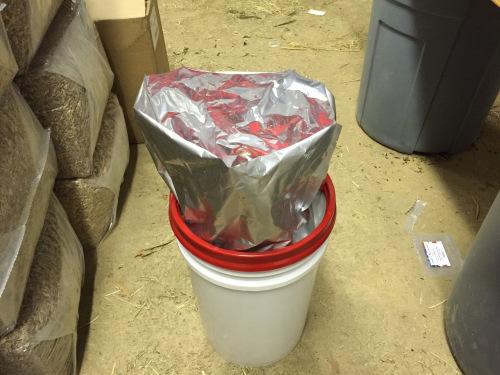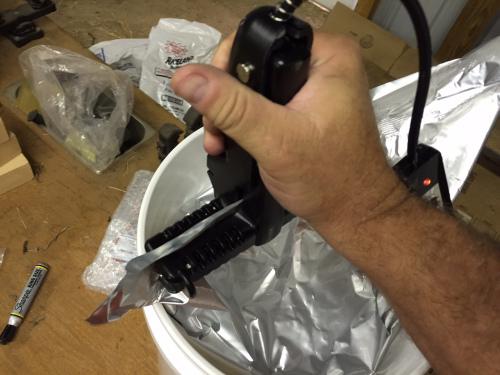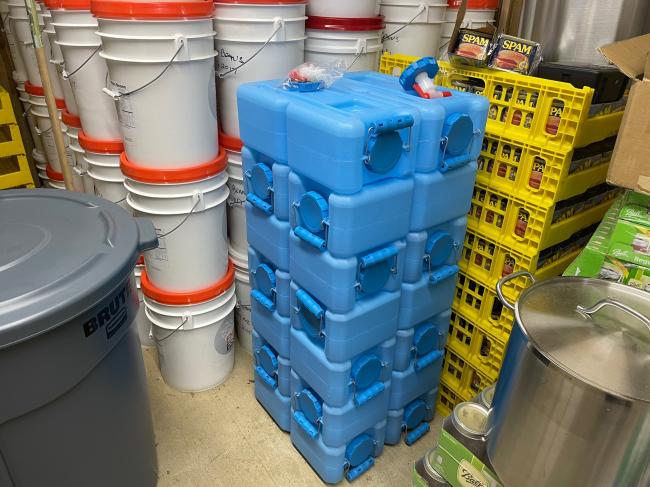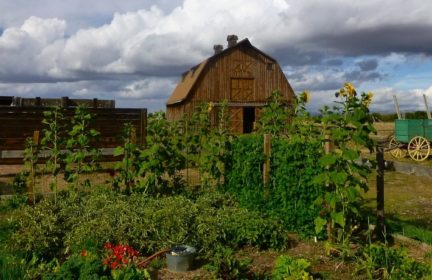How to you start building up a food storage that you could eventually live off of?
In this forum post: (https://theprepared.com/forum/thread/are-you-new-to-preparedness-ask-whatever-you-want-here) Michelle had brought up how she was able to live off of her food storage during a time of unemployment. I’ve been building up my food storage slowly when I have had some extra money but I would like to take it to the next level and get serious about my food storage. How do I build up a reliable food storage that I could potentially live off of 100% if I ran out of money and couldn’t buy any more food from the grocery store? I like to buy fresh food as much as I can, what should I do about that? I guess I could pick up gardening. Thank you everyone!
-
Comments (13)
-
RedneckContributor - March 10, 2021
Well with wanting to use fresh food, the best way to preserve it & still retain most of that freshness is by freezing. Much of our garden crops go into our freezers to be eaten thru the year… especially during winter. That of course requires an investment in multiple freezers plus you have the inherent risk of loosing everything if the power goes off for an extended period.
IMO, the best way to have reliable food storage, is to store the staples in mylar bags, with oxygen absorbers inside, all inside a 5 or 6 gallon plastic pail with lid. I keep several thousand pounds of such food in storage. If not allowed to get too hot, you can expect 25+ years of storage life. I store items such as wheat berries (I have 2 grain mills), white rice, beans, pasta, rolled oats, powdered milk, etc. Mine are stored in a special built prepper room with its own ac unit, so it never gets above 65 in there.
And yes, gardening is key IMO. Much of our fresh veggies come from the garden.
-
Jessica Sanders - March 10, 2021
@Redneck are mylar bags like Ziploc bags but made of mylar like mylar balloons? Can you go over the process of storing food that way a bit more? I don’t have a big freezer, so that might be something I’m interested in. Thank you for your comment.
-
RedneckContributor - March 10, 2021
No, they are sealed with heat. Some folks use a hair curler. I use a special sealer.
So you put your food in a mylar bag. I go ahead and put it inside the pail.
Once mostly full, I run a heat seal all the way across except for about an inch. I then add the oxygen absorber in that opening, push out as much air as possible then finish the seal. Then to be safe, I run another seal above the first one.
Here are some in storage.
-
Jessica Sanders - March 12, 2021
@Redneck thank you so much for the pictures. I’m a visual learning and understand now. That seems pretty easy to do, especially with that neat tool you have.
-
RedneckContributor - March 13, 2021
It is very easy to do & much cheaper than buying commercial product already packaged. Take for example long grain rice. Augason Farms sells a 6 gallon pail with 42 lbs of rice for around $100 to $186. Even at that price, I don’t think you can find any online. Everyone is out of stock, And if I remember correctly, Augason Farms does not use Mylar bags… just an oxygen absorber. You can do it yourself for around $30.
Now here is what it costs you to do it yourself… and better. Unit costs are based on purchasing around 10 sets.
6 gallon pail & lid from Uline: $10 https://www.uline.com/Product/Detail/S-11862W/Pails/Plastic-Pail-6-Gallon-White?pricode=WB0549&gadtype=pla&id=S-11862W&gclid=EAIaIQobChMIr-6c69qt7wIVzD6tBh2vMw6SEAQYASABEgI4sfD_BwE&gclsrc=aw.ds
Mylar bag with oxygen absorber from Amazon: $3 https://www.amazon.com/10-Mylar-Bags-Gallon-Absorbers/dp/B00EUDQKU2/ref=sr_1_8?dchild=1&keywords=5+gallon+mylar+bags+with+oxygen+absorbers&qid=1615653538&sr=8-8
Long grain rice from Sam’s Club (.39/lb): $16.50
That totals to around $30 for 42 lbs of food that will store for 25 years+. You can buy lots of cheap bulk food at Sam’s Club or similar. I put up dried beans, rice, dried pasta, sugar, salt, etc. from there. Then I purchased bulk wheat berries & rolled oats online & repacked in my pails.
You will need a way to seal the bags. My top of the line sealer costs around $100 on Amazon. Many people use hair straightening irons. I have lots of food, seasonings, salt, sugar, etc. sealed up in storage so it was easy for me to justify the expense of such a great sealer. When you compare the cost of commercially prepared storage food, it pays for itself very quickly. https://www.amazon.com/Portable-Sealer-Model-KF-150CST-Storage/dp/B003HO30TE/ref=sr_1_4?dchild=1&keywords=mylar+sealer&qid=1615653791&sr=8-4
-
-
UbiqueContributor - March 10, 2021
Hi Jessica, I believe you are in Chicago from the other posts and are also concerned about power outages? Forgive me if I have my wires crossed on that one.
Some people abhor canned food, but the fastest way for a person in an apartment or living with power outages that doesn’t have access to a generator, should consider canned foods as a basic start.
From there, barring power outages that are not long lasting, there are dried and freeze-dried foods.
Freeze-dried food requires little to no actual cooking (add water or warm water and stire). They are more expensive,but they have a lengthy storage period. Note the storage time changes after opening these types of foods. Note with a marker when you open them and the revised storage period after opening.
Dried foods stored in buckets, like legumes, white or brown rice will require longer cooking. My bulk food store has an excellent dried vegetable mix that is very good rehheated.
Spread your storage over frozen, canned and dried (or freeze-dried) to accomodate as many emergency scenarios as possible.
I have used my preps for financial crises and can tell you it is what kept the situation from becoming much worse.
With respect to gardening, if you are new to it great! It is a good way to shore up self-sufficiency skills. Just remember not to put all your eggs in one basket – spread your risk around over various methods. Even experienced gardeners have bad years.
The Extension services for your State will also have excellent food storage information and can possibly be a resource for other information regarding building a pantry.
-
Jessica Sanders - March 10, 2021
@Ubique you are right on with the Chicago and power outages. I think I can definitely stock up on some cans and that would be an easy way to get started. I like what you said about having different forms of food, canned, freeze dried, and frozen. Kind of like what the financial planner at my work says that I should do about diversifying my portfolio. But how do I know that I have enough food to live off of if I couldn’t get to the grocery store? I don’t want to be in the situation where I am trying to make a casserole and I am missing one ingredient. I guess I’m going to have to just plan out my meals and list all the ingredients they all take and make sure I have some of each of all of those.
-
UbiqueContributor - March 10, 2021
Jessica, I also used menu planning at the beginning. Then I factored the servings of each food I had in storage. I also considered how much room I had and then at how could we survive on the least amount of ingredients from a sound nutritional standpoint.
For us that was a core storage of brown rice (my storage is very cool and it doesn’t go rancid on me), whole grain pasta, large flake oatmeal, All Bran cereal, wheat germ, ground flax seed, wheat bran and unbleached and whole wheat flour for bread baking and to put into my husband’s breakfast oatmeal mix (the wheat germ, ground flax seed, wheat bran are added to make it whole grain and healthier).
Whole wheat bread has the same ingredients added plus oatmeal to make it super healthy.
Legumes, dried and canned are a huge part of my protein and good complex carb storage. There are so many things you can make with them with just a few ingredients and adapt to a variety of seasonings: soups, dips, bean burgers, chili, spreads. They are filling and nutritionally beneficial.
Dried fruit such as raisins and prunes were another item I began to store for nutritional value and the extra it added to breakfast foods or baking.
Baking ingredients, brown and white sugar, raw honey, maple syrup, baking soda, baking powder, chocolate chips, nuts, blackstrap molasses, flavourings like vanilla.
Eventually, I looked at how I could make various meals out of staples (I got lots of seasonings, salt, pepper and good quality chicken and beef boullion stocked up, too).
I now store many other items now that I have a feel for how we consume our preps. They are what we eat on a regular basis.
For example, my husband eats large flake oats with raisins for breakfast. I use it for baking and in my bread making.
I decant the 50 lb bag of old fashioned oats into 6 pails which are numbered. I know that when I open pail #, that it’s time to pick up more oats.
I developed a feel for how long canned tomatoes would last, by keeping records of when I replenished them. I also used a notebook to note dates and receipes made for the frozen meals I put away in the freezer.
By monitoring the stock levels in the pantry and doing something as simple as noting the ingredients taken out of storage and then replacing them, it is possible to get a good grip on what you have and how much you use.
As you get your pantry going, you will find a rhythm for managing it. At first a lot of note keeping, but it really does help. Write the expiry date on the cans so it is easier to read.
I have a systems for cans and other preps taken off of shelves: If I stand in front of my shelf, it is always top row, left to right. This way your expiry dates shouldn’t get messed up.
It takes time to get comfortable with how to stock and replenish, but it will come, Jessica. You can do it.
-
-
LNMOt - March 10, 2021
Hello! I can offer a few suggestions as I have spent the better part of the last year working on this as well.
1. Stock what you use, use what you stock in your prepper pantry. If there is an item you think you’ll need in a crisis situation that you don’t typically eat or use, then consider how you could start incorporating that item into your daily / weekly use.
2. Make a detailed list of the items you use the most and would want to have on hand. Don’t forget medicines, shampoo, conditioner, soap, contact solution, etc. If you’re like me and my family, there are a large variety of foods that we like to eat. But essentially you have to make decisions here: what are you going to “stock” in your prepper pantry and what are you not going to worry about right now. For me, this was heavily influenced by space constraints and ensuring adequate nutritional balance (complete proteins, etc).
2. Conduct “time usage studies” on the various foods and other essentials you have decided you would like to stock in your prepper pantry. I did this by just marking the date I opened a package (of raisins for example) and the date the package is used up. Let’s say it takes one month to get through a box of raisins. Next, determine how many months of food you want to have on hand in the event of a crisis. Factoring in the shelf life of the item, you can determine how many boxes of raisins you should target to have in your pantry.
3. Make sure to evaluate nutritional requirements – for example, quinoa is a complete protein. Beans and rice combined provide a complete protein. I would recommend keeping plenty of these items in your pantry.
4. Determine the area in your house where your prepper pantry will be located. Purchase or make your own heavy duty racking. Make sure to maximize space in the racking. If you have rodent issues, I suggest purchasing the large rubbermaid-type containers with locking lids and putting at risk foods in these.
5. Start stocking your pantry. I mark each and every can, bag or box of food in large letters with a sharpie with the expiration date and I make sure the units with a farther out expiration date are in the back and the units expiring first are right up front, ready to grab.
6. Take frequent inventories. Keep an eye on expiration dates and plan meals / rotate accordingly.
7. If you overbought or miscalculated, you can simply donate extra food to help those in need.
Hope this helped!
-
LNMOt - March 10, 2021
I forgot to mention about the “fresh food” items that aren’t shelf stable. I have a large garage refrigerator on top of our kitchen refrigerator. I use the same methodology for refrigerated / fresh items. At a given time I have about a month and a half of eggs in the fridge, 4-5 loafs of bread, fresh fruit, vegetables, etc. I know how long things will last and buy fresh fruit and vegetables at a staggered frequency.
-
Jessica Sanders - March 12, 2021
@LNMOt wonderful idea of storing other things besides food. Just the other day I ran out of laundry detergent and I had to put our dirty clothes on hold until I could get at the store. If I had some stored, I could have gotten them out of the way right then and there. How do you make your eggs and bread last so long? If I don’t eat a loaf a bread a week then it starts to mold!
-
-
Pops - March 11, 2021
Lots of good advice here. I’ll just second a few points.
Stock what you use then restock what you have used.
This is really important for several reasons. 1) You will never regret your purchases. 2) Your cooking and eating habits won’t need to change in stressful times. 3) Your family won’t notice. 4) It gets you in the habit of thinking about the future calmly.How?
Just continue doing what you’ve been doing. When you go grocery shopping, buy some extra, whatever dollar amount you decide. Lets just say your family likes green beans, buy $5 extra canned green beans. Come home and just add them to the shelf. Do that a few months and you’ll start needing a bigger storage area. That gives you some time to think about organizing your pantry, maybe buying/building a can rack etc. At some point you may want to start being more methodical but at first just buy more of what you use and fine tune laterWhen to say when?
It would be nice to have an unlimited pantry but that isn’t too practical so start with a goal you can achieve, a month, a year, you decide. Lets say your kids eat 3 cans of green beans a week, that’s 12 per month 72 in 6 months 144 for a year. Green beans last a while: 3 or 4 years easy, so your supply isn’t likely to spoil. But a gross of canned green beans takes up some space!Your biggest problems will be shelf life and shelf space—because again, you are not out any money, you’re just bought ahead. Shelf space is sorta ad hoc, everyone’s situation is different but dark and cool is best but stable is the most important, no big temperature swings. Shelf life is generally the limiting factor for stocking “regular” food in the pantry. Still most cupboard food will last a year.
Obviously you can’t store fresh food a year, that’s why there are so many ways of preserving food. I don’t really have any suggestions beyond growing a garden. It wasn’t all that long ago there were no tomatoes in the produce isles in January. Similarly a loaf of bread isn’t all that tasty after a year on the shelf so at some point you might want to start baking more, or at least practice if you don’t do a lot of scratch cooking now. Again, you want to be able to just continue your regular routine as much as possible if the paychecks stop, the less you are forced to change your regular routine, the clearer your head will be for the things that do change.
And, in the meantime, when you’ve built up a little cushion I guarantee you will feel a swell of pride and accomplishment every time you realize the item missing from the kitchen shelf is just a few steps away in the pantry.
-
Jessica Sanders - March 12, 2021
@Pops you have a great way of explaining things and making them super simple to understand. Buying an extra $5 of canned green beans when I go to the store is totally doable! I also like your last paragraph how I won’t have to run to the store if I run out of something in the kitchen.
-
-
- News for the Week 2024-04-15 - 2 days ago
- Chickens for preppers: Important considerations - 2 days ago
- Alexapure - 5 days ago
- Plants with Saponins - 1 week ago
- News for the week of 2024-04-08 - 1 week ago
This forum is heavily moderated to keep things valuable to as many people as possible. Full community policies are here. The basics:
- 1. Be nice to each other.
- 2. Stay focused on prepping.
- 3. Avoid politics, religion, and other arguments.
- 4. No unfounded conspiracies, fake news, etc.
- 5. Debate ideas, not people.







